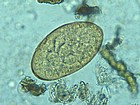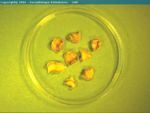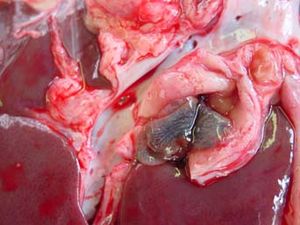| This article is still under construction. |
| Also known as: | Liver fluke, fluke, Fasciola hepatica | ]
FasciolosisThe adult liver fluke, Fasciola hepatica, lives in the bile ducts of a wide range of animals, including sheep, cattle, rabbits and, less often, horses. It can infect humans causing a painful abdominal disease. The intermediate host in the UK is a mud snail, Lymnaea truncatula. It causes significant economic losses in western parts of the British Isles due to deaths, clinical and subclinical cattle disease confined mostly to the younger stock. Fasciolosis is a seasonal disease with more serious outbreaks occurring in some years than in others. A similar but slightly larger species, F. gigantica, occurs in wetter tropical regions. Ovine FasciolosisAcute fasciolosis
NOTE: Acute disease is rarely seen in cattle Sub-acute fasciolosis
Chronic fasciolosis
NOTE: Calcification of bile duct in cattle → 'pipe-stem' liver Sub-clinical effects
Migration and pathologyMigrationMetacercariae excyst → immature flukes present in the small intestine → migrate across the peritoneal cavity (about 1 week) → to the liver → migrate through the liver parenchyma for 6-7 weeks becoming more destructive as they grow → enter bile ducts
Acute FascioliasisThe acute disease is a less common type of Fasciola hepatica, and generally occurs 2-6 weeks after large ingestion of metacercariae. The young liver flukes migrate through the liver parenchyma causing severe haemorrhaging, due to the damage to the liver vasculature. This occurs in late autumn and winter, mainly between the months of August to October. Outbreaks of acute fascioliasis usually present as sudden deaths. On examination infected animals are weak, with pale mucous membranes. They may also have enlarged livers, and the liver surface may be cover with a fibrinous peritonitis, particularly evident on the ventral lobe. Tracts become filled with blood and degenerate hepatocytes later infiltrated with eosinophils, lymphocytes and replaced by fibrosis. Subactute FascioliasisThis is caused by ingestion of metacercariae over a longer period of time. Some may have migrated to the bile ducts, causing cholangitis, whilst other metacercariae are migrating through the liver causing lesions similar to those present in acute fascioliasis. The infected host may present with severe haemorrhagic anaemia, with hypoalbuminaemia, rapid loss of body condition, reduced appetite, pale mucous membranes, and submandibular oedema may also be present. On post-mortem, an enlarged liver is common and haemorrhagic tracts are usually visible on the liver surface. If left untreated, it is often fatal. This form of fascioliasis occurs around 6-10 weeks after ingestion of the metacercariae by the host, and like acute fascioliasis occurs in late autumn and winter. Chronic FascioliasisThis is usually seen in late winter, early spring and is currently the most common fascoloiasis seen. It occurs around 4-5 months after ingestion of the metacercariae. Hypochromic and macrocytic anaemia and hypoalbuminaemia are common, as the adult flukes are capable of sucking up to 0.5ml of blood each day. In heavy infections, this can prove to be a severe loss. Infected animals may present with progressive loss of body condtion, reduced appeptite, which along with hypoalbuminaemia can result in an gaunt animal. Other common signs include pale mucous membranes, and submandibular oedema, more commonly known as 'bottle jaw.' On biopsy the liver will have an irregular shape, distorted shape with areas of fibrous tissue replacing the cells damaged by the migrating flukes. The bile ducts appear dilated, and dark, and it is often possible to express numerous numbers of adult flukes from within the ducts. Pathology is similar in both sheep and cattle, expect in cattle you may see calcification of the bile ducts, and enlargement of the gall bladder. The calcified bile ducts are often seen protruding from the liver surface, which is known as 'pipe stem liver.' Pathogenesis of acute fasciolosis
(Note: other complex events also occur, including disruption of haemodynamics, monolobular fibrosis, egg-granulomas etc.)
Pathogenesis of chronic fasciolosis
Disease manifestations
NOTE: chronic fasciolosis occurs at a time of year when animals are on a low plane of nutrition. This combined with the reduced food intake causes a significant effect on the development and severity of clinical and subclinical fasciolosis.
sheep>cattle>pig
Geographical distribution of diseaseTransmission is dependent on the snail, and therefore associated with snail habitats. These are more plentiful in high rainfall areas such as found on the western side of the British Isles, or alongside drainage canals in low-lying areas such as the Romney Marsh (or the Netherlands). It is important to remember that sheep and cattle are often bred in Ireland or western Britain and transported to the east of the country for fattening. Infected animals may therefore be found in areas where no transmission occurs. Weather patterns and disease riskWet summer Many fluke and snail eggs hatching and snail habitats expanded, therefore: → snail population increases rapidly → many infected snails → many cercariae shed → high density of metacercariae on herbage → increased risk of disease Dry summer Few fluke and snail eggs hatching and snails restricted to permanent habitats, therefore: → snail populations small and overcrowded → few infected snails, high mortality → few cercariae shed → few metacercariae confined to restricted areas → reduced risk of disease Forecasting FasciolosisSeveral prediction models have been developed. They evaluate the wetness of the soil from May to October by taking account of rainfall patterns and evapo-transpiration. Seasonal weighting factors are applied. June is a particularly influential month. A drought in late summer can reverse a potentially dangerous trend, and so unqualified forecasts should not be issued prematurely. A high snail density will only lead to disease if infection is present (i.e. if fluke eggs have been deposited onto the habitat by farm or wild animals). Local biological interpretation of computer generated predictions is therefore required. These forecasting models can provide valuable information for the farming community. MAFF (before DEFRA) used to provide an annual forecast, but this is now discontinued. DiagnosisThis is performed primarily on the clinical findings, seasonal occurance, as well as a previous history of fasciolosis on the farm. These along with post-mortem form the basis for diagnosis of Fasciola hepatica. In practice, diagnosis of ovine fasciolosis is often more straightforward than bovine fasciolosis. Examination of faeces for liver fluke eggs is also useful, and may be complemented by laboratory tests. Firstly the measurement of Glutamate dehydrogenase (GLDH) is used. This is an enzyme released by damaged hepatic cells, and levels become elevated within the first few weeks of infection. Another test commonly used is measuring the glutamyl transpeptidase (GGT), and this indicates damage to the epithelial cells of the bile ducts, and is seen later in the cycle, and maintained for a longer duration. An ELISA can also be used in the detection process. It identifies antibodies against flukes in the serum and milk samples, and is deemd to be extremely reliable in this case. Acute fasciolosis
Chronic fasciolosis
ControlAnthelmintics
Chemoprophylaxis
Vaccination
Molluscicides
Alternative strategies
TreatmentIf the fuke is present treat with triclabendazole, which is effective against all stages of Fasciola hepatica. Treatment should be applied in September/October and again in January, if faecal egg count is still postitive. One may also treat against adult only stages in May/June, preventing any future pasture contamination. However, do not use the same treatment in September/October as used in May/June, as resistance to drugs is becoming a real problem within the UK due to overuse. If it has been a particularly wet season, it may be necessary to treat again, as Fasciola hepatica becomes more prevalent under such conditions. Isolation and treatment of all new animals entering from another farm has also be shown to be effective. Other control measures include fencing off wet areas, and increasing soil drainage. |



